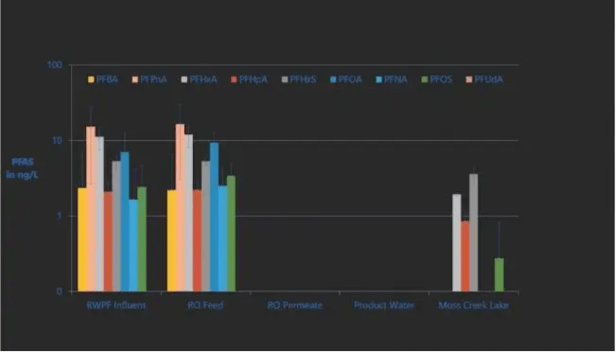PFAS in potable reuse: crisis or non-issue?
By Eva Steinle-Darling | WWD | April 20, 2020

Read the full article by Eva Steinle-Darling (WWD)
“Per- and polyfluoroalkyl substances (PFAS) are synthetic fluorinated organic compounds widely used in industrial, commercial and consumer products due to their oil and water repellent characteristics. Product applications include oil and water repellent surface coatings for packaging, textiles and cookware (e.g., pizza boxes, fabric coating, and non-stick frying pans) and firefighting foams. Over 600 manufactured compounds can be classified as PFAS, including perfluorooctanoic acid (PFOA) and perfluorooctanyl sulfonate (PFOS). These two perfluorinated compounds were produced in the largest amounts within the U.S. but were largely phased out and replaced by shorter-chained analogs over the last 15 to 20 years.
The presence of PFAS in water supplies is concerning for affected water systems because of their potential for adverse health effects at low nanogram-per-liter (ng/L) concentrations and the limited removal achieved through conventional treatment processes. With this in mind, in May 2016, the U.S. EPA established a 70 ng/L drinking water health advisory (HA) for the sum of PFOA and PFOS. Since then, more than 10 states have promulgated enforceable standards, some of which are significantly lower than the federal HAs. Furthermore, many utilities have established their own goals to meet the federal HAs or more stringent goals, such as California’s Notification Levels of 6.5 ng/L for PFOS and 5.1 ng/L for PFOA. A number of states are also developing receiving water quality standards and limits in biosolids that could significantly affect water reclamation facilities in the future.
Meanwhile, a number of federal legislative efforts in 2019 were proposed to compel the U.S. EPA to regulate PFAS across all water-related media. As one of the first steps under its PFAS Action Plan, in February 2020, the USEPA announced its intent to develop enforceable MCLs for PFOS, PFOA and potentially, other PFAS compounds.
These regulatory developments have put water and wastewater agencies on edge and in some cases, left them scrambling to comply with rapidly changing requirements. To date, regulation of PFAS has affected mainly drinking water utilities, especially those relying on groundwater contaminated with PFAS. However, recognizing that typical wastewater effluent and biosolids contain background concentrations of PFAS in almost every region of the country, regulation of PFAS in discharges and biosolids could have much far-ranging impacts.
PFAS in Potable Reuse
Over the past few decades, potable reuse has emerged from obscurity and is now generally accepted as a potential source of new water supply. Potable reuse is a compelling water supply option in many water-stressed places because it is both local and drought resistant. Even parts of the U.S. not typically considered water-short are now pursuing potable reuse because it can provide the dual benefits of water supply and nutrient discharge avoidance. Still, potable reuse sometimes suffers from lingering issues with public perception. Given the recent impact of PFAS on other aspects of the water and wastewater industry, it is important to determine the consequences potential new regulation andnew public awareness of PFAS will have for potable reuse projects.
In conventional groundwater treatment projects designed to address PFAS, the treatment technology of choice is typically (pseudo-)adsorptive, namely granular activated carbon (GAC) or ion exchange. Other treatment methods are typically ineffective or cost-prohibitive. However, the calculus on PFAS treatment is different in potable reuse, in which cost- and energy-intensive processes are the norm. The vast majority of potable reuse projects will implement some form of advanced water treatment (AWT), which will rely on a small number of core treatment processes to remove both regulated and unregulated chemical constituents. These processes can be grouped roughly into two categories: membrane-based AWT and carbon-based AWT.
Membrane-Based AWT
Most existing potable reuse projects rely on reverse osmosis (RO) as the key treatment process for removing unwanted dissolved constituents. However, these membranes are extremely effective at removing PFAS compounds as well.
Figure 1 demonstrates this effectiveness at the Raw Water Production Facility Direct Potable Reuse (DPR) Facility in Big Spring, Texas (adapted from Steinle-Darling et al., 2016). In 2013, this facility became the first and only operating municipal DPR project in the U.S. There, treatment consists of microfiltration (MF), RO, and UV advanced oxidation prior to blending with other raw surface water supplies.
Many U.S. facilities use this treatment model for indirect potable reuse via groundwater recharge. The challenge with this approach is the concentrate produced by the RO process, which constitutes approximately 15% of flow. As concerns about PFAS compounds in the environment mount, their presence in RO concentrate may contribute to challenges with its disposal…”
This content provided by the PFAS Project.
Location:
Topics: